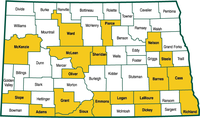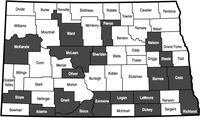Determine Grazing Readiness Prior to Pasture Turnout
(Click an image below to view a high-resolution image that can be downloaded)
The recent warm temperatures may have producers itching to get their livestock out on pasture, but they need to make sure their forages are ready to be grazed before turnout.
“Grazing forage too early in the spring can be costly in terms of total forage production during the entire grazing season,” North Dakota State University Extension Service rangeland management specialist Kevin Sedivec says. “Grazing before grass plants reach the grazing readiness phase causes a reduction in herbage production, which can reduce stocking rate and animal performance.”
The timing of grazing readiness depends on a number of factors, including the species of grass, available moisture, weather and past management. As a result of these factors, the exact timing of grazing readiness can vary across a state.
To address this variability and help landowners identify grazing readiness in their area, Sedivec and NDSU Extension livestock environmental stewardship specialist Miranda Meehan are working with 18 Extension agents across the state to monitor grazing readiness this spring.
The specialists say that grazing readiness for most domesticated pasture is at the three-leaf stage, whereas grazing readiness for most native range grasses is the 3½-leaf stage.
In North Dakota, most cool-season native range grasses typically reach grazing readiness in mid to late May, which is the recommended time to begin grazing native range. Domesticated grass pastures, such as crested wheatgrass and smooth brome, reach grazing readiness two to four weeks earlier than native range, permitting grazing in late April to early May.
“It is important to monitor grazing readiness of your pastures prior to turnout,” Meehan says. “Because of the ecological and economic impacts of grazing native rangeland prior to grazing readiness, the rangeland may take years to recover if livestock are allowed to overgraze for many years in a row.”
For more information on determining grazing readiness, contact your county office of the NDSU Extension Service or visit http://tinyurl.com/grassmgmt for NDSU Extension’s “Ranchers Guide to Grassland Management IV.”
NDSU Agriculture Communication _ April 12, 2017
| Source: | Kevin Sedivec, 701-231-7647, kevin.sedivec@ndsu.edu |
|---|---|
| Source: | Miranda Meehan, 701-231-7683, miranda.meehan@ndsu.edu |
| Editor: | Ellen Crawford, 701-231-5391, ellen.crawford@ndsu.edu |
Attachments
- EPS color - These counties are participating in an NDSU Extension Service project to monitor grazing readiness. - (540.5029296875 kb)
- EPS black - These counties are participating in an NDSU Extension Service project to monitor grazing readiness. - (536.7724609375 kb)
- PDF - These counties are participating in an NDSU Extension Service project to monitor grazing readiness. - (399.7353515625 kb)



